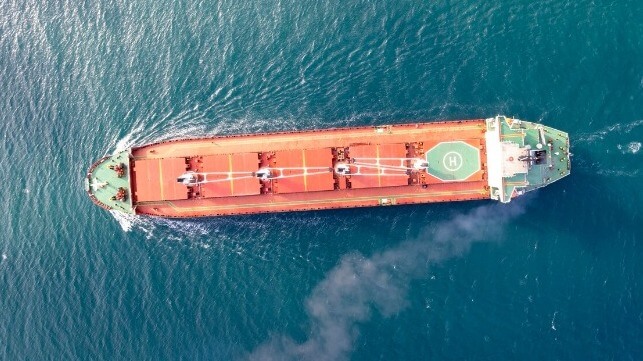Cape of Good Hope Diversions Threaten CII Grades - and Show Value of Data

The shipping industry has been enveloped by a sustained period of intense geopolitical volatility. Previous challenges - like the emergence of the Russian ‘dark fleet’ and the reduction in traffic through the Panama Canal - have now been superseded by the mass re-routing of vessels via the Cape of Good Hope, in order to avoid the Red Sea.
Among the myriad of consequences that transiting around the Cape of Good Hope will have on the shipping industry – one that has gone largely unreported – is the significant impact that rerouting can have on a vessel’s IMO carbon intensity indicator (CII) grade. Our data shows that rerouting around the Cape has traditionally changed a vessel’s behavior. Consequently, recent data reveals an average 10% increase in speed when sailing around the Cape, compared to using the Suez Canal.
Given that speed’s relationship with fuel consumption is not linear, this increase can have profound consequences on fuel consumption and the carbon intensity measured to develop a CII ‘letter rating’. To provide an example, for a 100,000-DWT gas tanker, a 10% speed increase for a transit around the Cape from Europe to Southeast Asia will add approximately ten days to its transit time. This translates into a fuel consumption rise of 291 tonnes, which is equal to an additional conservative estimated bunker fuel spend of $175,000, while adding 920 tonnes of CO2 to the atmosphere.
Critically, the hidden impact of this change in behavior is that the same vessel would see a 17% increase in carbon intensity under the CII framework. A vessel’s CII grade is effectively an annual rating, and therefore this would signify a significant risk of a negative change in its letter rating the following year. The consequence of this is that the user of the vessel is effectively blind to how that vessel is operating – and how it will be rated – until the end of the year.
In other words, the stark reality is that the vessel charterer has no knowledge or influence on how a journey might affect an overall annual CII letter rating. This could be hugely disadvantageous for cargo owners committing to a “B” rated vessel, for example, only to discover – mid-time charter – that the ship has been re-rated to a “C” or “D”.
Another example of a need to rethink is in emissions reporting for IMO Data Collection System (DCS) and EU MRV. The Energy LEAP alliance’s VERS (Vessels Emission Report Standard) initiative is running a trial that allows DCS and MRV-relevant emissions data from vessels – each producing dozens of pieces of data per day, which are shared and accessed by regulators, ports, charterers, and shipowners – to be safely stored and accessed through a single repository.
The case of VERS and the CII / Cape scenario establish a compelling rationale for a more modern, ubiquitous, and transparent standardization of marine data intelligence. Global data storage is projected to exceed 200 trillion gigabytes next year, yet shipping continues to rely on legacy processes, or holds data in silos, creating huge inefficiencies and barriers to industry progress. In many ways this personifies the antithesis of what marine assurance is meant to provide.
As the VERS trials illustrate, the solution to these antiquated processes is already established and proven. There are systems already that allow stakeholders in the shipping industry to seamlessly share and access accurate, real-time data, which will then provide charterers, ship operators, traders, and port and terminal operators access to the required data quickly, securely, and reliably. With real-time visibility into cargo movements, stakeholders can proactively address any issues, anticipate delays, and ensure timely delivery - thereby creating better risk management, which would in turn reduce losses and damages.
Technology is not the barrier; legacy and human nature is
A common, paperless, data exchange would dramatically streamline compliance and regulatory processes – with a focus on limiting human intervention – and would save millions of human hours per annum. This is not to disregard the need for due process, risk management, and keeping safety as paramount, but rather introduce a means of conducting the same tasks significantly more effectively and efficiently.
However, there remains an industry reticence towards a move to data standardization, centered – understandably – on trust and security. The irony of this legacy attitude towards peer-to-peer standardization is that despite the initial hesitance, the industry is steadily moving towards a greater level of data sharing between parties anyway, with regulations already in place to facilitate the sharing of data. Regulations such as the EU MRV, and EU ETS – which build on the reporting requirements of MRV – as well as increasing provision for data sharing clauses within charterparty agreements, and the Sea Cargo Charter, all establish frameworks for accessing a disclosing data between parties.
The processes are already in place, and trust in a new, modern way of working for shipping is quickly building. All that is now required to truly revolutionize the industry is a systemization of these processes to create a more transparent, intuitive, efficient, and secure industry-wide data exchange framework.
Dominic McKnight Hardy is the managing director at MIS Marine.
The opinions expressed herein are the author's and not necessarily those of The Maritime Executive.
No comments:
Post a Comment